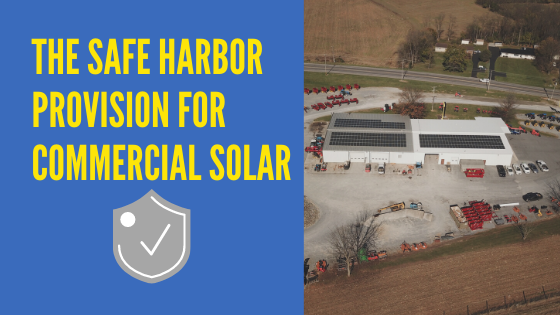All good things must come to an end, and in 2021, the 26% federal tax credit will step down to 22%. In 2022, the credit is scheduled to drop to 10% for commercial solar projects and go away completely for residential solar, making now the time to invest in solar energy if you want to save money on your taxes.
The good news is businesses and farmers can secure the 26% credit now by taking advantage of the safe harbor provision.
The safe harbor provision allows commercial solar projects to take advantage of 2020’s 26% tax credit, even if their system can’t be installed until the following year(s).
What Is The Safe Harbor Provision For Solar Energy?
In order to get the solar tax credit, your solar system must be installed and energized in the year you’re claiming the tax credit. However, since this might not be possible with the end of the year quickly approaching, the safe harbor provision allows you to secure the 26% federal tax credit now even if your solar installation won’t be completed this year. However, there are a few steps you will need to complete in order to receive the 26% tax credit rate.
How Do I Comply With The Safe Harbor Provision?
If you’re a business or farm looking to install a solar system, you can take advantage of the full 26% tax credit in 2020 if your solar system is completed within three years of 2020 (by 2023) and you fulfill the requirements in one of the following two options:
Option 1: Paying at least 5% of the system’s cost before 2021
Option 2: Beginning construction on the project before 2021 and with continuous work (recommended for very large projects only)
Safe Harbor Option 1: The 5% Investment
The Method
For this option, you must pay at least 5% of the project’s total cost in 2020. The solar installer must use that 5% deposit for legitimate project costs before the stroke of midnight on January 1, 2021. That payment is non-refundable, even if you decide later on down the road that you do not want to install the system.
What costs could be covered by your 5% investment? They could be anything like engineering; permitting; interconnection fees and applications; utility upgrades or new services; or materials for your system, like racking, inverters, or modules. Which of these options is dependent on the timing, your system, and your situation.
Engineering, permitting, interconnection, utility upgrades, and new services can take some time to complete. If there are only a few weeks left in 2020, it may not be possible to put the necessary work in place. If it is later in the year, it may be possible to purchase products instead. However, solar products will likely be in tight supply, which is why we are doing what we can now to prepare for the demand.
However, there is a downside to using the 5% investment to purchase materials for your system. The customer will be responsible for storing the equipment until the project is installed, which for some businesses, can be a challenge. Delivery of the project is able to be delayed through Mid-March of 2021, however, while still complying with the safe harbor. Which is best depends on your project and situation, as well as how long after 2020 your system will be installed.
The Risks of This Method
In order to satisfy the safe harbor requirements, at least 5% of the system’s cost must be invested in the system prior to 2021. If your project increases in price for any reason, making the money you invested less than 5%, you’ll no longer be eligible for the 26% tax credit. Whether it’s because of factors outside of your control, like tariffs or code changes, or you’d like to redesign your system, the investment made in 2020 must be 5% of the final cost of the project.
In order to ensure you’ll qualify for the safe harbor, you may want to contribute slightly more than 5% in the event the project’s price increases. While 6% or 7% should be safe, it’s a good idea to check with your solar contractor. Regardless of the amount, the payment is not refundable. If you decide to not install your project for any reason, you will lose the investment.
Additionally, be sure that your applications or permits do not expire before the project is built. Make sure you know when your project will be installed, whether that’s within a few months of the New Year, or a year after.
It’s also important to note you could be subject to an audit from the IRS. Make sure you have all of your paperwork in order proving your 5% investment by the end of 2020. Check with your tax professional to ensure all your bases are covered.
Option 2: Beginning of Construction with Continuous Work
The Method
This option is most often going to apply to very large projects. It requires two conditions to be met. Work on the project has to be started in 2020, and it has to progress in a continuous nature. That means buying one panel and having your contractor drop it off on your property before 2021 and then not working on your project until 2022 won’t work.
To satisfy this option for the safe harbor, there has to be evidence that some portion of the project has started, whether that’s on-site or off-site work, and that it has continued after 2020. This could include purchasing components specific to your project, beyond what your contractor normally has in their inventory.
As long as the work is significant in nature, it should comply with the safe harbor, but “significant in nature” is up for interpretation. There is no specific amount of work or monetary investment needed to qualify for the safe harbor in this option, though the IRS indicated the taxpayer must make a “continuous effort to advance towards completion of the energy property.” Consult with your tax professional for your particular situation.
The Risks of Option 2
Option 2 is the trickier of the two options because of its ambiguity. If you rely on this method, you should be prepared to defend the continuity of the project’s work to the IRS, knowing that they’re well-versed in all the explanations. You should also be able to back your claims up with documentation. Because of the difficulties for both the customer and the contractor, many solar installers will advise you two stick with the first of the safe harbor options, the 5% investment.
Slipping up on this could cost you. If a mistake is made, you may not only lose the 4% difference in the ITC, but you could also lose out on the ITC all together and incur expensive professional costs as you work with the IRS.
As long as you partner with a reputable, experienced solar contractor, the safe harbor is a safe and effective way to ensure you’ll be getting the most out of your solar investment. Be sure to consult your trusted tax professional to ensure all your bases are covered before proceeding with the safe harbor.



